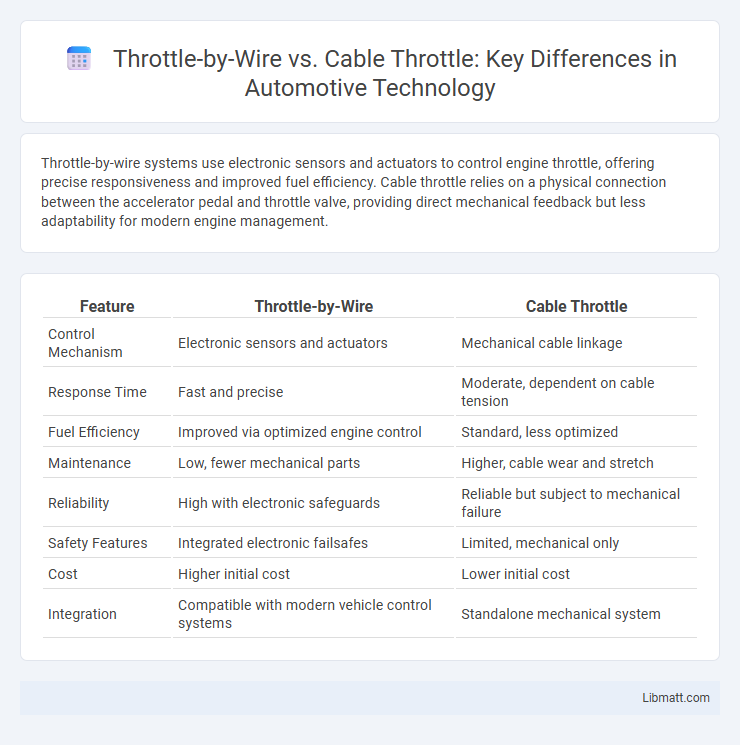Throttle-by-wire systems use electronic sensors and actuators to control engine throttle, offering precise responsiveness and improved fuel efficiency. Cable throttle relies on a physical connection between the accelerator pedal and throttle valve, providing direct mechanical feedback but less adaptability for modern engine management.
Table of Comparison
| Feature | Throttle-by-Wire | Cable Throttle |
|---|---|---|
| Control Mechanism | Electronic sensors and actuators | Mechanical cable linkage |
| Response Time | Fast and precise | Moderate, dependent on cable tension |
| Fuel Efficiency | Improved via optimized engine control | Standard, less optimized |
| Maintenance | Low, fewer mechanical parts | Higher, cable wear and stretch |
| Reliability | High with electronic safeguards | Reliable but subject to mechanical failure |
| Safety Features | Integrated electronic failsafes | Limited, mechanical only |
| Cost | Higher initial cost | Lower initial cost |
| Integration | Compatible with modern vehicle control systems | Standalone mechanical system |
Introduction to Throttle Systems
Throttle-by-wire systems replace traditional cable throttle mechanisms with electronic sensors and actuators, offering precise control over engine performance. Unlike cable throttles, which rely on mechanical linkages, throttle-by-wire improves responsiveness, reduces maintenance, and enhances fuel efficiency. Your vehicle benefits from smoother acceleration and advanced integration with stability and traction control systems using this modern technology.
What is Throttle-by-Wire?
Throttle-by-wire is an electronic throttle control system that replaces the traditional mechanical cable linking the accelerator pedal to the throttle body. It uses sensors to detect pedal position and sends signals to an electronic control unit (ECU), which then adjusts the throttle valve accordingly. This technology enhances precision, response time, and allows integration with advanced safety and performance features like traction control and adaptive cruise control.
Understanding Cable Throttle Mechanisms
Cable throttle mechanisms use a physical wire connected directly from the accelerator pedal to the throttle body, allowing immediate mechanical response. This traditional system relies on the tension and integrity of the cable to control engine airflow, ensuring a straightforward and tactile connection. Unlike throttle-by-wire systems, cable throttles lack electronic sensors and actuators, which can lead to less precise control but simpler maintenance.
Key Differences Between Throttle-by-Wire and Cable Throttle
Throttle-by-wire systems replace traditional mechanical linkages with electronic sensors and actuators, offering precise throttle control and improved fuel efficiency. Cable throttles rely on physical cables connected to the accelerator pedal, providing direct mechanical feedback but less adaptability to modern engine management systems. Your choice affects responsiveness, maintenance needs, and integration with advanced vehicle technologies like traction control.
Advantages of Throttle-by-Wire
Throttle-by-wire systems offer precise electronic control over engine throttle, enhancing fuel efficiency and reducing emissions compared to traditional cable throttles. The absence of mechanical linkages results in smoother throttle response and allows integration with advanced driver-assistance systems such as traction control and adaptive cruise control. Improved reliability and reduced maintenance costs are additional advantages due to fewer moving parts susceptible to wear and friction.
Benefits of Traditional Cable Throttle
Traditional cable throttle systems offer direct, mechanical control over engine response, providing a reliable and straightforward connection between the accelerator pedal and the throttle valve. This mechanical linkage is favored for its simplicity, ease of repair, and independence from electronic interference, making it highly durable in harsh environments. Furthermore, cable throttles ensure immediate throttle input feedback, which can enhance the driver's sense of control and predictability in vehicle performance.
Common Issues and Reliability Concerns
Throttle-by-wire systems commonly face issues with signal interference, sensor calibration errors, and software glitches, which can lead to delayed throttle response or unintended acceleration. Cable throttle mechanisms often suffer from mechanical wear, cable fraying, and binding, resulting in inconsistent throttle control and increased maintenance. Reliability concerns for throttle-by-wire hinge on electronic component durability and software integrity, while cable throttles are primarily challenged by physical component degradation over time.
Performance and Responsiveness Comparison
Throttle-by-wire systems deliver superior performance and responsiveness compared to traditional cable throttles through electronic sensors that precisely control throttle opening without mechanical delay. This technology enables faster throttle response, improved fuel efficiency, and smoother acceleration by continuously adjusting the throttle position based on real-time engine and driver inputs. Cable throttle systems, limited by physical cable tension and mechanical wear, often exhibit slower reaction times and less consistent throttle control under varying conditions.
Safety Features and Considerations
Throttle-by-wire systems enhance safety by electronically managing throttle response, allowing integration with advanced driver-assistance features like traction control and stability management. Cable throttle systems rely on direct mechanical linkages, which may be prone to wear and require regular maintenance to ensure consistent performance and safety. Your vehicle's overall safety benefits from throttle-by-wire's precise control, reducing the risk of unintended acceleration and improving response in emergency situations.
Choosing the Right Throttle System for Your Vehicle
Choosing the right throttle system for your vehicle depends on factors such as responsiveness, maintenance, and compatibility with modern engine management technologies. Throttle-by-wire systems offer precise electronic control, improved fuel efficiency, and integration with advanced safety features, making them ideal for contemporary vehicles. In contrast, cable throttle systems provide a simpler, mechanical connection that is easier to repair and preferred in older or performance-focused cars where direct driver feedback is crucial.
Throttle-by-wire vs Cable throttle Infographic

 libmatt.com
libmatt.com